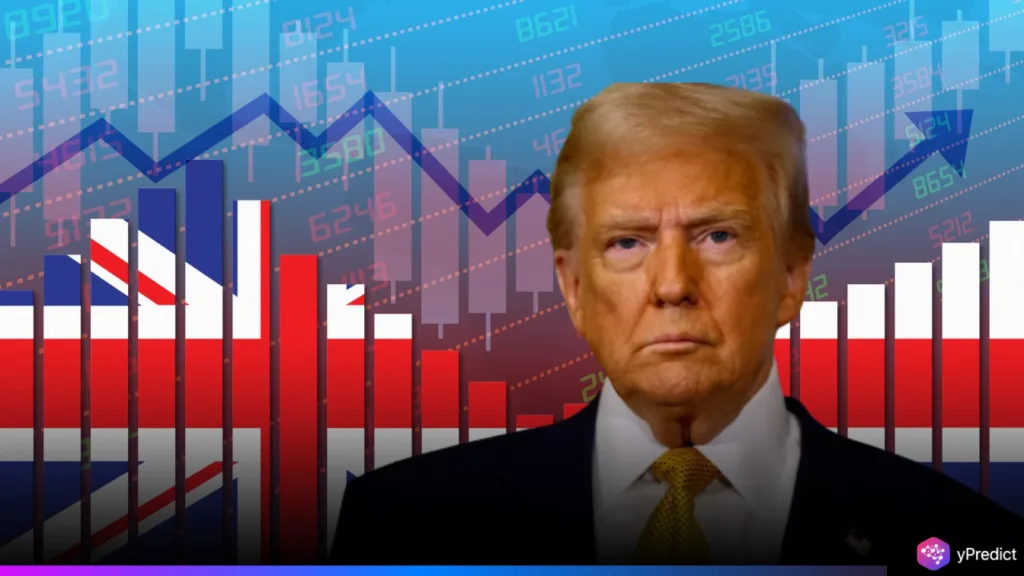
The UK economy contracts sharply in April 2025, with GDP falling by 0.3%, triggering economic concerns nationwide. Shrinking exports to the United States and rising fiscal pressures at home fueled this significant economic decline. The downturn reflects the combined impact of revived Trump-era tariffs and recent domestic tax increases implemented by the government. With trade volumes plunging and consumer demand fading, April marked the UK’s steepest monthly contraction since early 2023.
Exports to the U.S. Collapse, Services Sector Weakens
The Wall Street Journal reports that Britain’s economy shrank by 0.3% in April, exceeding analysts’ expectations of a smaller drop. This contraction, the sharpest since October 2023, stemmed from growing international trade tensions and rising domestic fiscal pressures. Analysts had predicted a more modest 0.1% decline, based on a consensus poll conducted before the report’s publication.
The Office for National Statistics (ONS) reported a decline followed 0.5% and 0.2% GDP growth in February and March. April’s contraction signals a sudden, broad slowdown in economic activity after the year began with relatively strong momentum. In the first quarter, UK GDP rose 0.7%, outperforming both the eurozone and the United States during the same period.
Global trade tensions, fueled by the Trump administration’s tariffs, including a 25% duty on autos and 10% on British goods, led to a record £2 billion drop in UK exports to the U.S. in April. Manufacturing output fell 0.6%, with the auto sector slashing production amid weakening demand.
Domestic Pressures Mount with Fiscal Tightening
April also marked the rollout of new tax policies under Chancellor Rachel Reeves, including increases in National Insurance contributions and corporate taxes aimed at boosting public investment. Meanwhile, domestic challenges exacerbated the decline. Businesses faced higher national insurance contributions and an increase in the minimum wage beginning in April.
The expiration of a temporary property tax exemption triggered a sharp decline in home sales and real estate activity. The UK’s dominant services sector shrank by 0.4%, driven by reduced housing, legal, and conveyancing activity. Retail, finance, and consulting firms reported project delays and cost-cutting amid rising taxes and inflation.
The construction sector was the rare bright spot, expanding by 0.9% on the back of increased homebuilding. Still, the overall picture remains bleak, with the latest HMRC data showing payroll employment declined by 109,000 in May, the most significant drop since the first COVID-19 lockdown in 2020.
Speaking to the press, Chancellor Rachel Reeves acknowledged that April’s figures were “clearly disappointing” but argued they were not unexpected given the global uncertainty. She pointed specifically to weakening exports and declining production as signs of business hesitation driven by unpredictable trade dynamics.
Uncertainty Clouds Outlook Despite Mild Growth
Investment sentiment is weakening as global trade uncertainty forces UK business leaders to act cautiously with spending and expansion plans. Bank of England Governor Andrew Bailey stated that firms are delaying irreversible decisions, which stalls hiring and capital investment. Economists remain divided; some view April’s downturn as temporary, while others warn of lasting weakness as past export gains decline.
Despite April’s poor showing, quarterly growth remains slightly positive. However, the BoE has cut its 2026 forecast and warned that tariffs could reduce GDP by 0.3% over three years. While the bank recently raised its 2025 forecast to 1%, concerns over long-term sustainability persist. Interest rates are expected to stay unchanged at the next meeting, though a potential cut in August remains on the table if inflation shows signs of easing.







